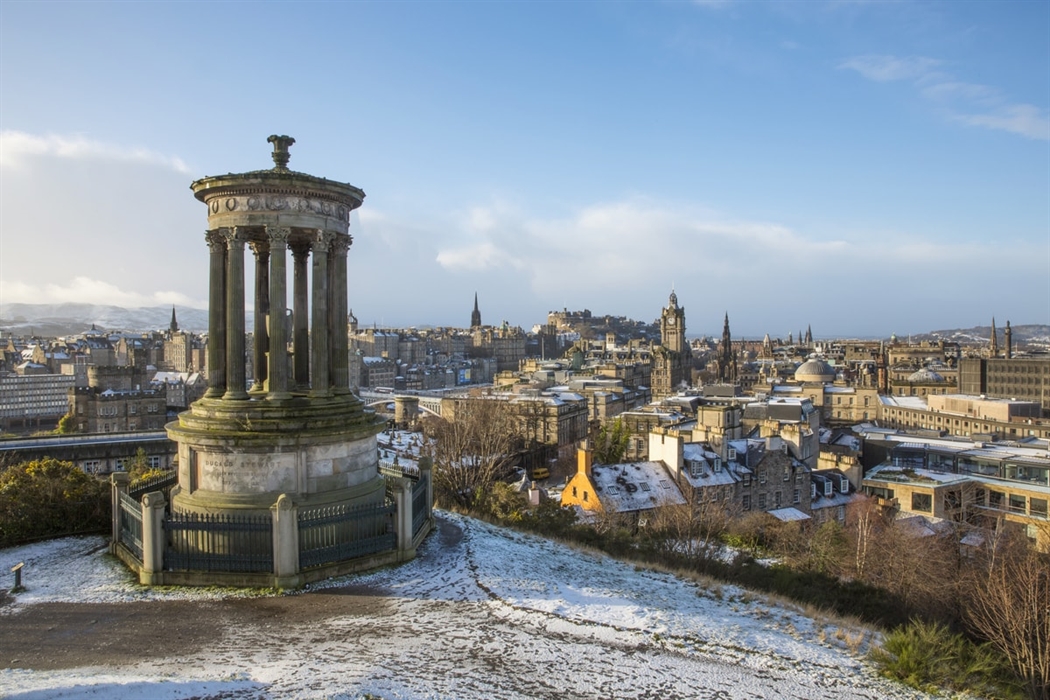Calton Hill
Calton Hill is a hill in central Edinburgh, Scotland, situated beyond the east end of Princes Street and included in the city's UNESCO World Heritage Site. Views of, and from, the hill are often used in
photographs and paintings of the city.
Calton Hill is the headquarters of the Scottish Government, which is based at St Andrew's House, on the steep southern slope of the hill; with the Scottish Parliament Building, and other notable buildings, for example Holyrood Palace,lying near the foot of the hill. The hill is also the location of several iconic monuments and buildings: the National Monument, the Nelson Monument, the Dugald Stewart Monument, the old Royal High School, the Robert Burns Monument, the Political Martyrs' Monument and the City Observatory.
Nelson Monument
The upturned telescope was designed by the architect Robert Burn, and was built between 1807 and 1815.
In 1852, a large time ball was introduced, which is lowered as the one o'clock gun is fired from Edinburgh castle each day.
Climb this monument for stunning views over the city!
Scott Monument
SIR WALTER SCOTT ( 1771- 1832) was born in Edinburgh. He was a lawyer, but his writing became
so popular that he gained an enormous following and respect. Scott
was invited to attend he coronation of George IV in 1821, and he also
helped organise the King's visit to Scotland the following year.
Scott died in 1832 at his home, Abbotsford House. His works inlcude Waverley
& Ivanhoe.

The Scott Monument is a
huge gothic tower was built to commemorate his work.
Rising
to 200ft 6 inches high it contains a spiralling staircase of 287 steps
and offers magnificent views from the top spire.
Built
of light sandstone, the pollution from traffic over the years has darkened
it considerably.
Seated
under the huge arches of the tower is a solid marble sculputure of Sir
Walter Scott with his beloved dog ' Maida' carved by sculptor John Steell.
The acropolis is in fact an unfinished monument - originally called the
"National Monument". Initiated in 1816, a year after Napoleon's defeat
at Waterloo, it was meant to be a replica of the Parthenon in Athens, as
a memorial to those who had died in the Napoleonic Wars:
Building began in 1822, but funds ran dry and celebrated Edinburgh
architect William Playfair only saw a facade of his building completed.
It was dubbed "Edinburgh's shame", but it's now a popular landmark and
it's a lot of fun crawling up and down its giant steps. Plans since to
complete the building never really get much support.
William Henry Playfair, architect (1790-1857) greatly shaped Edinburgh
into the city that we can see today. His contribution to the
architecture of early 19th century Edinburgh is found throughout the
city and its environs - with many of his most noteworthy buildings and
landscapes located in the Old and New Towns. By focusing on Playfair’s
built and unbuilt proposals within the City Centre, this exhibition will
demonstrate his vision and ambition for the city as a place of
significance within the British Isles, and will follow his career from
the Neo-Classical Enlightenment period of the Northern Athenian city, to
the rapidly industrialized Edinburgh of the Victorian age.
Robert Burns Monument
Burns was a brilliant lyricist and he contributed over 100 songs to a book called The Melodies of Scotland. He also wrote lyrics for A Select Collection of Scottish Airs for the Voice and The Scots Musical Museum.
On 21st July 1796, Robert Burns died at the age of 37. His body lies to rest in the Burns Mausoleum in St Michael’s Churchyard, Dumfries.
Every year the Scots still celebrate his birthday on January 25th as a remembrance to a great poet. 'Burns Night' is celebrated with a meal of Haggis, Neeps & Tatties. Before the haggis is cut open, Burn's poem 'Address to the Haggis' is read where he refers to it as "chieftain of the Puddin' race" meaning Chief of all puddings.
His best known work 'Auld lang Syne' is sung at New Year the world over.
Click here to listen to 'Auld lang Syne'
Old Observatory
In fact, there are two observatories on Calton Hill: the Old Observatory House, designed by New Town architect James Craig in 1792; and the City Observatory, built in 1818, which has exhibitions and viewings of the night sky.
 |
| Old Observatory |
The City Observatory
City Observatory was inspired by a Greek temple of the Four Winds, the Observatory was
designed by William Henry Playfair in 1818. The first Astronomer Royal
to work in this building was Professor
Thomas Henderson, appointed 1834, who had discovered how to measure
parallax and the distance to a star.









Brak komentarzy:
Prześlij komentarz